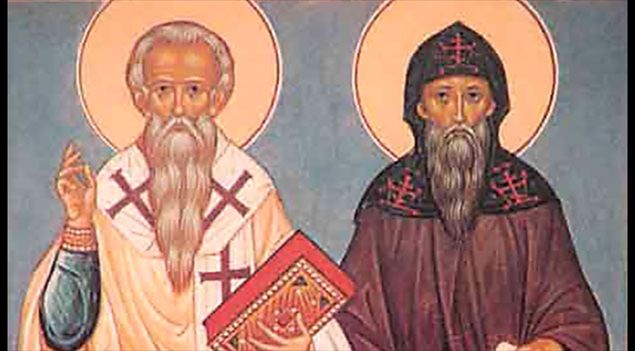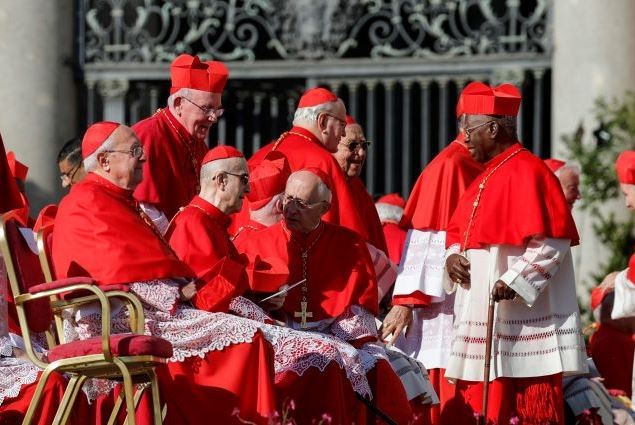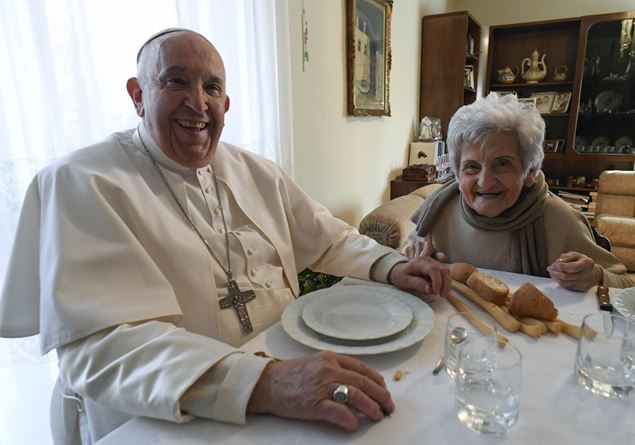There are not a few cases of brothers venerated as saints from the church, among which we want to remember in particular the patriarchs Moses and Aaron, the apostles Peter and Andrea, the martyrs Cosma and Damiano, the Russian protomarters Boris and Gleb, Sant’Annibale Maria and The servant of God Francesco Maria of France, Saint Paul of the Cross and the venerable Giovanni Battista Danei, the blessed Giovanni Maria and Luigi Boccardo, the venerable Antonio and Marco Cavanis, the servants of God Flavio and Gedeone Corrà.
Pope John Paul II, on 31 December 1980 with the Apostolic Letter Egregiae virtutis wanted to place two brothers, Cirillo and Methodius, As patrons of Europe together with San Benedetto, as evangelizers of the Slavic peoples and therefore of the eastern part of the old continent. These are two saints never canonized by the Popes, of which only in 1880 the Pontiff Leone XIII had extended the cult to the universal Church.
Originating from Tesalonica, a Greek city at that time belonging to the Byzantine Empire, Cyril and Methodium evangelized in particular Pannonia and Moravia in the ninth century. Little news, however, has been handed down about Cyril and his brother Metodio. We know that Cirillo was actually called Constantine and later adopted the name Cirillo as a monk, towards the end of his life. Further information about their activities came up to us thanks to two “Vitæ”, drawn up in Paleoslav, also known as “Pannonical Legends”.
The letters that the then pontiff aimed at methodio and the “Italian legend”, written in Latin, are also preserved. The latter tells that in Velletri the bishop Gauderico, devoted of Pope San Clemente, whose relics were moved to Italy by Cirillo, wanted to redeem a report on the latter’s life.
Due to the undeniable scarcity of historically reliable sources, numerous legends have flourished around the figures of Cirillo and Methodius.
The most important mission to the Slavic peoples
Natives of Thessaloniki (in Slavo Solun), an offspring of a noble Greek family, their father Leone was drungario of the city, a position that followed him a high social status. According to the “Cyrilli Vita”, the latter was the youngest of seven brothers and already at an early age it seems to have expressed the desire to devote himself entirely to the pursuit of wisdom. At a young age he moved to Constantinople, where he undertook theological and philosophical studies.
Tradition has it that among its precedents there was the famous Patriarch Fozio and Anastasio Librarian, reports of the friendship that between the two, as well as a doctrinaire dispute that occurred with each other.
Cyril’s typical curiosity demonstrated his eclecticism: he cultivated notions of astronomy, geometry, rhetoric and music, but was in the field of linguistics that could prove his genius. In addition to the Greek, Cirillo was also currently spoken of Latin, Arabic and Hebrew.
From Constantinople, the Emperor sent the two brothers to various missions, also to the Arabs: it was during the mission to the Càsari that Cirillo found the relics of Pope San Clemente, a Gospel and a salter written in Russian letters, as the ” Vita Methodii ”.
The most important mission that was entrusted to Cirillo and Methodius was that at the Slavic populations of Pannonia and Moravia. The sovereign of Moravia, Rostislav, then died martyr and revered as a saint, asked the Byzantine emperor to send missionaries to his lands, hiding the political factor of the worrying German presence in his kingdom behind religious motivations.
Cirillo gladly accepted the invitation and, arriving in his new land of mission, he began to translate songs of the Gospel of John to invent a new alphabet, called Glagolitic (from “гograma” which means “word”), today better known as the Cyrillic alphabet. Probably for some time now he had ventured into the elaboration of an alphabet for the Slavic language. However, conflicts with the German clergy, the first evangelizer of those lands, did not delay.
In 867 Cirillo and Methodius went to Rome to order priests of their disciples, but perhaps their visit was dictated by an explicit call by Pope Adriano II suspicious of the friendship between Cyril and the heretic Fozio.
In any case, the pontiff reserved them a positive welcome, He ordered priest Methodio and approved their translations of the Bible and liturgical texts in Slavic language. In addition, Cirillo gave him the relics of San Clemente, found by him in Crimea.
The invention of the Cyrillic alphabet
During the stay in the Eternal City, Cirillo fell ill and died: it was February 14 869. He was buried right at the Basilica of San Clemente. Metodio then returned to Moravia, but during a subsequent trip to Rome he was consecrated Bishop and assigned to the Sirmun headquarters (today’s Sremska Mitroviča).
When his nephew Sventopelk, in favor of the German presence in the kingdom, succeeded Moravia in Rostislav, thus began the persecution of the disciples of Cyril and Methodium, seen as bearers of a heresy.
The same method was held for two years in Bavaria and finally died at Velehrad, in the south of Moravia, on April 6, 885. His disciples were imprisoned or sold as slaves in Venice. A part of them managed to flee to the Balkans and it is no coincidence that in Bulgaria they venerate like seven apostles of the nation of Cirillo, Methodius and their disciples Clemente, Nahum, Saba, Gorazd and Angelario, commonly celebrated on 27 July. The Martyrologium Romanum and the liturgical calendar instead dedicate to the brothers Cirillo and Metodio the feast of February 14, on the anniversary of the death of the former. If the immense work of the two brothers of thessalonica was canceled in Moravia, as mentioned, he found luck and continuation to Bulgarian land, also thanks to the favor of the sovereign San Boris Michele I, considered “Isadopostolo”, who embraced Christianity and made his religion national.
The vast activity of the disciples of Cirillo and Methodium in this country gave rise to Bulgarian literature, thus laying the foundations of the written culture of the new great Russian States. The Cyrillic approached the Bulgarians and all the Slavic peoples to the Greco-Byzantine world very close: this alphabet was made up of thirty-eight letters, of which twenty-four taken from the Greek alphabet, while the other specially designed for the Fonetic Slavic. This involved great ease in transplanting the enormous Greek literary tradition into Slavic. The new language supplanted the Glagolitic everywhere and made the name of its creator famous until the present day.










